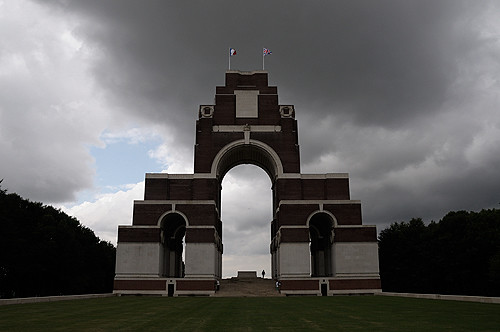
In the area there are two things that can be seen from almost anywhere. One is the Golden Madonna on the spire of Albert Basilica, famously knocked horizontal (and later knocked off) by German artillery. The other is the brooding Thiepval Memorial. Wherever you are, the arch of this massive structure seems to watch you like an unblinking eye. It's also surprisingly hard to get to. Despite being well signposted, it jumps around the landscape, always in the middle distance until - suddenly - there it is right in front of you. It's a moving and desperately melancholic place. There are more than 72,000 names carved here - all men without a known grave. Here and there, a name has been removed after the remains of a long lost brother, son, uncle or father have been discovered and carefully exhumed from their hurried battlefield grave, identified, and given a proper burial.

Modern agricultural methods have turned the Somme area into miles of luminous prairie, broken up by the glowing Portland stones of the immaculate Commonwealth cemetries - 188 in this area alone - but there are some patches where the war is still very evident. There are woods with no trees more than 90 years old. Near the site of the former Kiel trench is a paddock with three horses living among a series of trenches and craters. Farmers around here are still using British and German iron pickets for their original purpose - to hold up barbed wire and the amount of ordnance still brought up by the plough means a regional bomb disposal squad is on permanent standby. In the first week of the Battle Of The Somme nearly two million shells were fired by the British alone. A third of these were duds, and a lot of them are still out there.
 The scale of loss and sacrifice is at the same time humbling and overwhelming. Each day we were glad to get back to Albert for a glass of Loburg and a steak haché, and after three days we were relieved to move on. Driving up the arrow-straight road from Albert to Bapaume on our way to Lille we followed the direction of the British advance - which cost 3 lives for every foot of land captured.
The scale of loss and sacrifice is at the same time humbling and overwhelming. Each day we were glad to get back to Albert for a glass of Loburg and a steak haché, and after three days we were relieved to move on. Driving up the arrow-straight road from Albert to Bapaume on our way to Lille we followed the direction of the British advance - which cost 3 lives for every foot of land captured.
 The scale of loss and sacrifice is at the same time humbling and overwhelming. Each day we were glad to get back to Albert for a glass of Loburg and a steak haché, and after three days we were relieved to move on. Driving up the arrow-straight road from Albert to Bapaume on our way to Lille we followed the direction of the British advance - which cost 3 lives for every foot of land captured.
The scale of loss and sacrifice is at the same time humbling and overwhelming. Each day we were glad to get back to Albert for a glass of Loburg and a steak haché, and after three days we were relieved to move on. Driving up the arrow-straight road from Albert to Bapaume on our way to Lille we followed the direction of the British advance - which cost 3 lives for every foot of land captured.
5 comments:
I found the woods - particularly around Thiepval - to be strange brooding places. One knew that most were relatively young in tree-age terms, yet all seemed to hold dark secrets, an impression fostered by the number of signs sternly advising 'private - no entry'. Did you call in on the Ulster memorial tower, just down the lane from Thiepval?
Hi Affer. Yes we did, which after all the cemeteries and memorials we found a curiously cheerful place. Did you see the German machine gun post (although a lot of web chatter by Them Who Know reckon it's an observation post) on the field track just outside the gates?
I went to Thiepval, Ypres and that area just after Christmas last year - a very sobering sight to see the graves of lads almost half my age. One of the things I wasn't expecting was to see the German war cemetries.
I missed the MG post - but you are so right about it being cheery. A gaggle of Brits were visiting and there was much laughter. AND the marvellously-accented Norn Iron lady in the cafe made me a proper cheese-and-ham sandwich, in proper sliced brown bread! None of that foreign baguette stuff here, pal!
Velky Al, We went to the Soldatenfriedhof at Fricourt. While the Commonwealth cemeteries aren't exactly a barrel of laughs, there's something especially dour about the German ones.
Affer - I saw some photos of veterans visiting the Ulster Tower shortly after it was built. It was still in more-or-less untouched battlefield. All the vets were posing with shells that they'd picked up. I think there was even a crashed 'plane.
Post a Comment